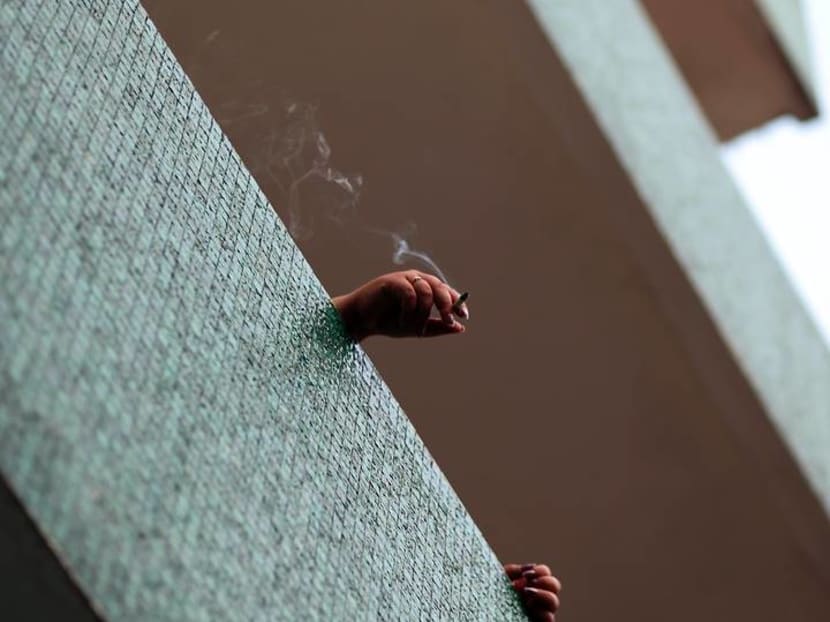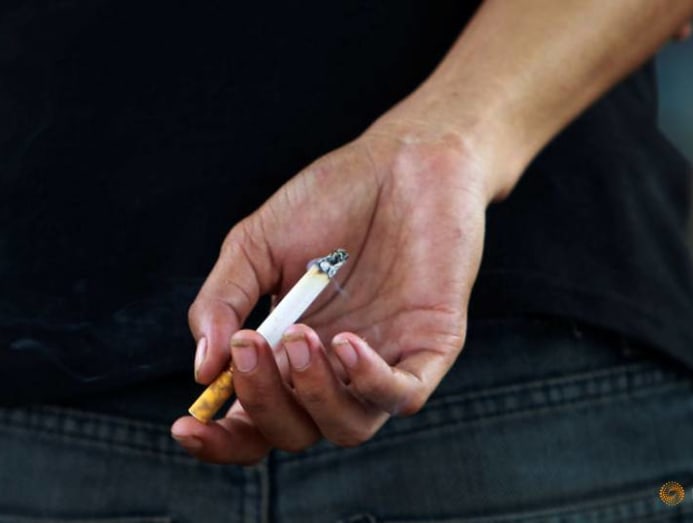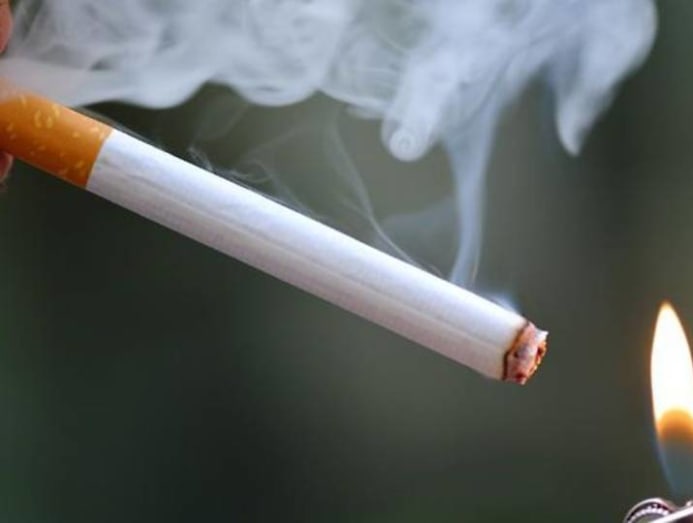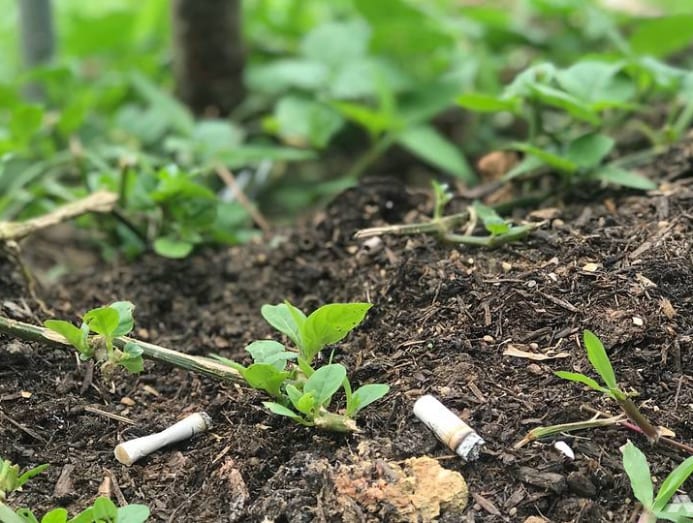commentary Commentary
Commentary: Smoking near windows dismissed as neighbourly nuisance but has public health costs
As people spend more time at home, smoke wafting into people’s homes can be a deadly public health menace, and should not be mistaken for a neighbourly nuisance or a gripe about smoking from non-smokers.

File photo of a person smoking at a balcony. (Photo: Unsplash/S Alb)
SINGAPORE: Singapore has been a tough place for a smoker to live in.
Smokers cannot seem to catch a break, particularly with the suggestion to ban smoking near home balconies and windows by Nee Soon GRC Member of Parliament and Group Parliament Committee for Sustainability and Environment Louis Ng in October reviving a national debate about how far the country should go to combat smoking completely.
Make smokers close their windows when they smoke, some suggested.
Ban smoking altogether, a few frustrated netizens said.
LISTEN: Is it time to go after smokers who light up near the windows of their homes?
TOUGH MEASURES AGAINST SMOKING IN RECENT YEARS
Singapore has rolled out a slew of increasingly aggressive legislative measures to stem the habit, especially over the last three years
Shops have not been allowed to display cigarettes openly since 2017.
Tax hikes in 2018 have raised the duties on cigarettes by 10 per cent.
Ugly health warning labels and standardised packaging have been imposed following amendments to the Tobacco Act, and have gone some way to stigmatise the habit.
Laws have also been tightened to raise the legal age of smoking, since the National Health Survey 2010 study showed eight in 10 smokers were hooked before turning 21.

And to stem demand for alternative tobacco products acting as easy gateways to cigarettes for youths, like e-cigarettes and shisha, a ban on their possession, purchase or use was imposed in 2018.
In fact, this multi-pronged effort to stem smoking in 2018 was so publicly visible, Dean of the NUS Saw Swee Hock School of Public Health Dr Teo Yik Ying coined it the year Singapore attempted to snuff out smoking.
READ: Commentary: The year Singapore attempts to snuff out tobacco
Smokers today are also no longer free to light up anywhere they want in smoke-free Orchard Road and have to stand in bright yellow boxes if they do.
Such efforts have borne fruit. The smoking rate has dropped from 14.3 per cent in 2010 to 10.6 per cent in 2019.
This is a significant achievement to be lauded, when the Health Ministry had previously revealed in 2018 that smoking incidence had fluctuated between 12 per cent and 14 per cent over the past decade with no clear pattern of decline.
Smoking rates should be brought down where the public health costs are high. At least S$600 million a year in direct healthcare costs and lost productivity for Singapore according to a 2014 estimate in renowned medical journal BMJ Open.
Some public health experts, like Prof Chia Kee Seng, have gone even further to call for exterminating smoking completely seeing that it is “an archaic habit with no place in modern society”.
READ: Commentary: Smoking is an archaic habit with no place in modern society
TACKLING SMOKING AT WINDOWS A PRIORITY
People ultimately should be able to do what they want at home, many say. But when it comes to smoking, all of us - smokers and non-smokers - know it’s a whole different ball game.

For one, while smokers have it bad in terms of the health effects, those around them also bear the costs of their habit.
This used to apply to family members stuck at home with the smoker, but has taken on broader meaning when the pandemic unleashed Singapore’s biggest shift towards work-from-home (WFH) and home-based learning.
Smoking-related complaints in HDB areas rose nearly six-fold in the first nine months of 2020 compared to the whole of 2017, Senior Minister of State for National Development Sim Anne revealed in Parliament last week.
READ: Commentary: When Singapore homes become workspaces – huge changes in the house and beyond
Even that rise may be an underestimate considering how many of us tend to be polite residents embarrassed to be raising a ruckus every time our neighbour smokes or creates a minor inconvenience.
“Work-from-home is the new normal. People used to work in the office. They come home, and for one or two hours, the neighbours may smoke once or twice in the evenings. But people now are home most of the time, and they may face a whole day of secondhand smoke,” Mr Ng said to me on CNA’s Heart of the Matter podcast.
The consequences can be serious. “A lot of the residents complained to me about secondhand smoke because their children have asthma … yet they have a neighbour who’s constantly smoking at their windows,” Mr Ng highlights.
“Imagine if your neighbour is spraying toxic chemicals out of his house and you’re breathing it in … that’s exactly what secondhand smoke is.”
READ: Commentary: COVID-19 offers fresh impetus to quit smoking
“There is no safe minimal level of secondhand smoke,” Dr Yvette van der Eijk from the NUS Saw Swee Hock School of Public Health shared on that same episode.
“Secondhand smoke contains something like 60 carcinogens and hundreds of chemicals known to be toxic ... It may be more dangerous for our health than what smokers inhale ... because (these are) not burnt completely,” she highlighted.
SINGAPORE’S APPROACH TO HEALTHCARE HAS ALWAYS BEEN INTERVENTIONIST
When this latest smoking ban suggestion was resurfaced in October by Mr Ng, concerns over intrusiveness and enforcement mushroomed online, which have been surprising to me.

Singapore has arguably taken an aggressive, interventionist approach to public health for decades.
Countless compulsory immunisation programmes, like those against measles and diphtheria, which saw the mass vaccination of infants and school children as part of the National Childhood Immunisation Schedule, have been accepted without much fuss.
Even when such programmes are opt-in, like the BCG shot that guards against tuberculosis, the take-up rate has been close to 100 per cent for decades. Similarly high rates for the opt-in Human Papillomavirus vaccination programme for Secondary 1 girls, which started last year, are also expected.
READ: Commentary: Making sense of shifting goalposts in public policy and the science of COVID-19
Public acceptance of enforcement against other endemic diseases, like the National Environment Agency’s checks against dengue, which can come with fines but require the permission of residents for inspections, have also been well received.
I suspect people do understand and accept rules that regulate individual behaviour which could have community health ramifications.
READ: Commentary: Uncovering the factors fueling record-high dengue cases in Singapore
The practicalities of enforcing a ban on smoking near windows need to be taken into account but the technology does exist.
Cameras are already used to detect high-rise littering and thermal scanners smoking in common corridors. Extending their use to watch for smoking may be worth considering for a stronger, public health imperative.
During the podcast, Mr Ng showed us an image taken by these cameras of a smoker throwing cigarette butts out of their window.

“That’s how powerful our cameras are - powerful in the sense that … they’re not intrusive … if you’re sitting in your sofa or lying on your bed, they can’t capture you but if you’re at your balcony, leaning out and smoking, then they can capture you.”
But he was also quick to caution that such means should be a last resort, and the laws be left to provide a strong deterrence against smoking near windows and shift social norms in the same way Singapore has treated littering.
For an MP whose GRC has gone out of the way to build smoking boxes to accommodate smokers, he understands how much of a middle ground is needed.
READ: Commentary: Youth smoking is a problem, so is youth vaping
IN STEP WITH DETERRING SMOKING ALTOGETHER
As Singapore moves towards a scheme of national health insurance to pool risks and costs surrounding hospitalisation (through MediShield Life) and disability (Careshield Life) and strengthen these programmes in the spirit of collective responsibility, it may only be a matter of time before an arguably even more intrusive step of pricing in smoking is taken.
Smokers usually pay a higher premium for life insurance policies compared to non-smokers, according to AIA Insurance, given the health risks tied to smoking.
In the US, smokers also pay up to 50 per cent higher for health insurance.
We may be some time away from that, but where Careshield Life already adopts actuarial principles like charging women higher premiums in line with insurance industry practice, and hikes in Medishield Life premiums have been proposed, that chicken might come home to roost sooner than we think.
READ: Commentary: When it comes to insurance, less is more for young adults starting out
And seen in these terms, banning smoking near windows is a small issue in the debate on smoking.
Even if you lay aside such trends, Mr Ng’s suggestion, as one that gets to the heart of the concern of smoke wafting into homes where people are spending more time in, including elderly and small children, is worth looking into.
Like Mr Ng said on our podcast, the challenge should be seen through a public health lens rather than one of neighbourly disputes or complaints by non-smokers.
Lin Suling is executive editor at CNA Digital News where she oversees the Commentary section and hosts the Heart of the Matter podcast.





